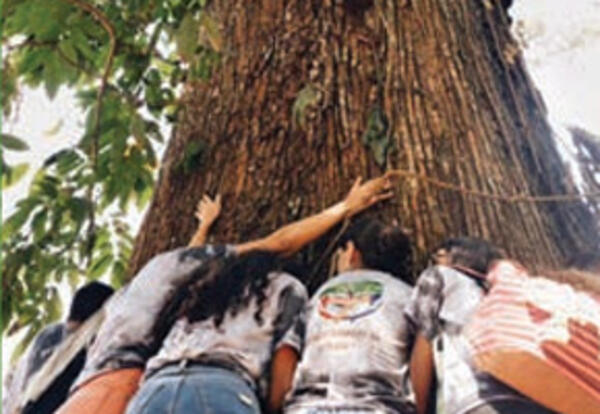
Young people hug the Brazil-nut tree, a survivor-tree at the sanctuary of Sister Dorothy's murder in February 2005.
by Sster Katheryne Webster, SNDdeN
The Forest Pilgrimage dawned clear and hot in Anapu, Brazil. In Centro São Rafael, the gravesite for Sister Dorothy Stang, SNDdeN, the team was ready. Sister Jane Dwyer, SNDdeN, worked with Jucimar, kitchen coordinator, as he put coffee in thermoses and prepared food for the noon meal, and for the next days. Youth of Anapu arrived, worked with “Women with Hands Joined” to put decorations at the center. Sisters Tecla da Silva Gaia, and Maria Vagner Sousa Silva, SNDdeN organized tee-shirts and hats for sale. Young people from 7 different counties arrived in buses. Pilgrims, receiving hugs, applause and songs, came individually or in smaller groups. All were ready at 3:00 p.m. for the departure from Anapu and four days on the road. In the pavilion, teams organized orientation and prayed for this Pilgrimage. We walk this Journey each year to honor Sister Dorothy Stang, SNDdeN who gave her life for the forest and for farmers who sustain themselves and their families on small pieces of land. We joined hands, forming a circle of dance around the tomb of Sister Dorothy! We go on our Journey to Esperança like the seedlings and young trees grown from Dorothy’s seed, planted in the earth in 2005. Rosaria Guzzo’s song is our theme: “Birthed and revitalized. T here is still hope in the struggle of the forest and the people!”
First Stop: Elementary School Santa Júlia, 7 km from Anapu
We pitched our tents, hung our hammocks, bathed and shared supper. After the meal, we sat to watch a video on the life, struggle and reason for the death of Sister Dorothy. Along the route to the school, people told stories and asked questions. Dialogue continued as Pilgrims remembered past struggles for the land. Yet 80% of these Pilgrims were 10 years-old or less, when Sister Dorothy was martyred in Esperança. Many were not even born. The route had practically no shade; trees had been cut down. The Pilgrims, hotter than ever felt sick. At midday, they used all cars available for transport over the 8 km without shade, over two steep hills. We stopped to drink water and to reflect on the importance of trees which had survived. We feel that the trees are indeed our brothers and sisters. “We feel the connection,” and with communities and families hosting us.
Project for Sustainable Development (PDS) in Esperança (Hope)
On Saturday, we reached the PDS on the land where Dorothy was martyred. The PDS is a model of Government Agrarian Reform, intended to favor poor farmers and families occupying and cultivating pieces of land for their sustenance. They defend the forest in using methods to farm the land, without clearing the trees. The standing forest gives sustained life while loggers, ranchers and miners cut and use the land for their own economic interests. At the entrance to the PDS, we reflected on the need to preserve the forest. We defend it and its people from the loggers, ranchers and miners with their deadly predatory activities. The problem and the solution are so clear! Pilgrims continued on foot to the Cross which marks where Dot was murdered. This space has become a sanctuary. On July 22, the Pilgrims found another tragedy. All trees, except for two huge Brasil-nut trees had been cut down. These trees which witnessed Dot’s murder were gone. The electric company said they cut the trees to clear the lines; the lines were really 20 meters away from the clearing. The Pilgrims made spontaneous statements, prayed and gestured to honor Dorothy, martyr of this environment, the forest. Once more, the sanctuary is made a cemetery. The Pilgrims gathered in the Meeting Center for songs, dances and thematic poetry, to defend the Forest! On Sunday, Pilgrims returned to the sanctuary for the closing Liturgy, prepared by communities and Youth Groups, with the Bishop of the Diocese of Xingu-Altamira presiding. Gentle leaves fell on singing Pilgrims. Each person left a green finger print stamped on the dead wood, symbols of commitment to preserve and bring the forest to rebirth. Green leaves filled the stumps. With spray paint, a poet put on the fallen logs:
"The death of the forest and flowers is the end of our lives."
First published in Good Works Volume 19. No. 2, October 2023
